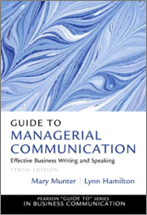1.1. Where was the training in report writing?
The most damning thing in this whole area is how random the training is. Report writers bring knowledge from their previous organisations and before long you have a potpourri of reporting styles that arrive on the executives’ desks.
I have worked for four major multinationals and none of them offered or gave me training in report writing. Their view was, ‘You have a degree so you should be able to write a report’.
Well, the answer is yes I can, but will it be convincing enough to get the important project that I am invested in over the line. Unfortunately, not in most cases.
I did however attend at my own expense a course on ‘business communication’ and the lessons have stayed with me ever since and will be penetrating into this toolkit.
1.2. A book you should devour
 We need to learn how to write reports in order to make them attractive to read. The reports need to be brief and follow 21st century best practice. I would recommend that you attend a business writing course, if you have not done already. The approach to writing we perfected in University is the exact opposite to what is required in business. A great book to read is Mary Munter’s “Guide to Managerial Communication: Effective Business Writing and Speaking” 10th Edition (Prentice Hall). From the information conveyed in Munter’s book you will learn to invert your writing similar to a journalists style. Starting with your recommendations and then answering the five whys. It makes for shorter reports.
We need to learn how to write reports in order to make them attractive to read. The reports need to be brief and follow 21st century best practice. I would recommend that you attend a business writing course, if you have not done already. The approach to writing we perfected in University is the exact opposite to what is required in business. A great book to read is Mary Munter’s “Guide to Managerial Communication: Effective Business Writing and Speaking” 10th Edition (Prentice Hall). From the information conveyed in Munter’s book you will learn to invert your writing similar to a journalists style. Starting with your recommendations and then answering the five whys. It makes for shorter reports.
1.3. Purpose of reports
Reports should be designed to encourage action to take place, on a timely basis, in the right direction. They thus need to:
| Timely | Be completed while management is still motivated to do something about the issue in question. |
| Structured | Be planned so they are structured with the reader’s decision in mind (especially written reports). |
| Utilise business writing best practice such as the guidelines in Mary Munter’s “Guide to Managerial Communication”.[i] | |
| Avoid unnecessary detail | Report meaningful numbers. Is it necessary to report Sales of $23,456,327? Surely $23.5 million is much easier to read and relate to. |
| Contain best practice graphics | Follow the guidelines of Stephen Few, an expert on data visualization. |
| Contain a ‘Florence Nightingale graphic’ to wow them and to live on past the life of the report. | |
| Consistent, concise and error free | Have consistent formatting and judgement calls. |
| Be concise – be a merging of numbers, graphs and comments on the one page where possible | |
| Be free of inconsistent numbers within the report, spelling, grammar and punctuation errors. |
1.4. A level of frustration
Board members and the senior management team have complained for years that they are sent too much information, yet we still insist on preparing 20-page month-end financials. The cost of preparing, analysing and checking this information is a major burden on the accounting function, creating significant time delays and consequently minimising its value.
The IT and Finance teams need to learn basic design principles, visual design and User experience (UX). As a CEO has recently pointed out to me:
“Our reports look ‘cool‘ but are completely unusable as our company logo is more important that than the content and the resulting navigational problems with split windows etc.”
“In my current and past job, we had a ton of decent information, but nobody really knew how to leverage it properly. I feel companies need to make it as easy and as compelling as possible to leverage information. That requires a bit of help and assistance. A well-developed reporting strategy and training goes a long way.”
This article is an extract from the toolkit How to write a report that people read and leads to a “Yes”
[i] Mary Munter, Guide to Managerial Communication: Effective Business Writing and Speaking

Recent Comments